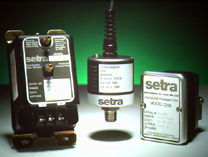AutomatedBuildings.com
Article - March 2000
[Home Page] |
[an error occurred while processing this directive]
(Click Message to Learn More) |
|
|
Setra
Pressure Transmitters
Help CALMAC'S Ice Bank®
System Cool Down
Customers
Efficiently, Cheaply
When it comes to meeting a building's air
conditioning requirements, certain times are better than others. In fact, you
might say that the difference is like day and night - literally.
|

Lawrence Griffin,
Product Mgr,
Setra Systems, Inc
|
When it comes to meeting a building's air
conditioning requirements, certain times are better than others. In fact, you
might say that the difference is like day and night - literally.
Without question, air conditioning during summer
daytime hours is the largest single contributor to utility "peak
demand" charges. After noon, as more air conditioners are required to
maintain comfortable temperatures, the increased call for electricity adds to
the high demand already created by lighting, office equipment, computers and
other electrical devices. This requires the utility to bring additional, more
costly generating sources on line to handle the increase. Consequently,
commercial users whose large air conditioning loads contribute to these added
generating requirements are assessed an additional charge based on their highest
on-peak demand for electricity.
The obvious solution is to shift as much as
possible of the electrical usage to the nighttime, off-peak hours, when a
building's electrical needs are at a minimum. This is the theory behind the Ice
Bank® Stored Cooling System from CALMAC® Manufacturing Corporation.
[an error occurred while processing this directive]The
system not only significantly lowers demand charges during air-conditioning
season but also decreases total energy usage, using a standard packaged chiller
to produce solid ice at night during off-peak periods. This also takes advantage
of the utility's underutilized generating capacity at night and lower customer
rates. The ice is built and stored in modular ice tanks to provide cooling to
help meet the building's air conditioning load requirement the following day.
This kind of innovation is nothing new for CALMAC
Manufacturing Corporation, the heating and air conditioning innovator best-known
as the market leader in the thermal energy storage industry. In fact, CALMAC's
Ice Bank product line accounts for 50% of all installations in the United States
and 75% of the export market.
Founded in 1947 in Englewood, New Jersey, CALMAC
has over 2,000 ice storage installations worldwide in over 30 countries on six
continents. Installations range from 30 ton-hr. capacity required by a
McDonald's franchise in Geneva, Switzerland, to the 30,000 ton-hr. needed for
the J.C. Penney headquarters in Plano, Texas. Their largest international
installation is located in the T&C Building in Kaohsiung, Taiwan, the 10th
tallest building in the world. The company is also one of the world's largest
manufacturers of ice making equipment for skating rinks.
Clearly, CALMAC could not have achieved such
impressive credentials unless its Ice Bank system were of superior quality.
Ironically, although the system's quality was unchallenged, the pressure
transmitters used in the system were beginning to become a real trouble spot.
"We had been using competitive transmitters
for some time, but we grew increasingly dissatisfied with their
performance," said CALMAC President Mark MacCracken. "They were
extremely sensitive and would go out of calibration regularly. In fact, it
happened quite frequently during shipping. And they were difficult to
adjust."
 Consequently, CALMAC decided to utilize pressure
transmitters from Setra Systems, Inc., of Boxborough, Massachusetts, a leading
designer and manufacturer of highly accurate capacitive-based pressure sensors.
The Setra System's Model C264, which CALMAC elected to use, senses differential
or gage (static) pressure and converts this pressure difference to a
proportional electrical output for either unidirectional or bidirectional
pressure ranges.
Consequently, CALMAC decided to utilize pressure
transmitters from Setra Systems, Inc., of Boxborough, Massachusetts, a leading
designer and manufacturer of highly accurate capacitive-based pressure sensors.
The Setra System's Model C264, which CALMAC elected to use, senses differential
or gage (static) pressure and converts this pressure difference to a
proportional electrical output for either unidirectional or bidirectional
pressure ranges.
To fully understand the critical role that the
transmitters play in the Ice Bank system, it is necessary to have a basic
understanding of the system itself. The Ice Bank system is a modular insulated
polyethylene tank containing a spiral-wound plastic tube heat exchanger
surrounded with water. At night, a 75% water/25% glycol solution from a standard
packaged air conditioning chiller circulates through the heat exchanger and
extracts heat until eventually about 95% of the water in the tank is frozen
solid. The fluid is at 25° F and freezes the water surrounding the heat
exchanger.
The following day, the stored ice cools the
solution from 52° F to 36° F. A temperature modulating valve set at 44° F in
a bypass loop around the tank permits a sufficient quantity of 52° F fluid to
bypass the tank, mix with the 36° F fluid, and achieve the desired 44° F
temperature. The 44° F fluid enters the coil, where it cools air typically from
75° F to 55° F. The fluid leaves the coil at 60° F, enters the chiller and is
cooled to 52° F.
The role of the Setra Model C264 pressure
transmitters is to monitor the change in water level created by the forming of
ice. The pressure transmitter is connected to one of two pneumatic tubes joined
by a "Y" connector to a single probe inserted into the water. (The
pressure transmitter is never in direct contact with the water.) A small
continuous volume of air is pumped through the probe, producing air bubbles out
the bottom. Expanding ice in the tank causes the surrounding water to rise. The
water level rises above the low point of the probe and the air pressure inside
the probe increases. The Model C264 senses this pressure and produces a
proportional output. The signal produced by the output is sent to a controller
where the pressure reading is displayed. This change in pressure indicates the
percentage of ice in the tank.
The impact of the Setra transmitters on the Ice
Bank product line has been significant, according to MacCracken.
"We have had far less callbacks on our
products; in fact, we have had none," he said. "Obviously, the quality
of our transmitters now is far superior to anything we have had before."
[an error occurred while processing this directive]
[Click Banner To Learn More]
[Home Page] [The
Automator] [About] [Subscribe
] [Contact
Us]

 Consequently, CALMAC decided to utilize pressure
transmitters from Setra Systems, Inc., of Boxborough, Massachusetts, a leading
designer and manufacturer of highly accurate capacitive-based pressure sensors.
The Setra System's Model C264, which CALMAC elected to use, senses differential
or gage (static) pressure and converts this pressure difference to a
proportional electrical output for either unidirectional or bidirectional
pressure ranges.
Consequently, CALMAC decided to utilize pressure
transmitters from Setra Systems, Inc., of Boxborough, Massachusetts, a leading
designer and manufacturer of highly accurate capacitive-based pressure sensors.
The Setra System's Model C264, which CALMAC elected to use, senses differential
or gage (static) pressure and converts this pressure difference to a
proportional electrical output for either unidirectional or bidirectional
pressure ranges.